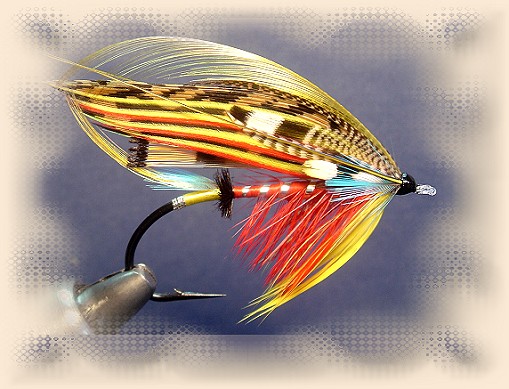Before launching into the history of this fly,
I thought I might take a minute and talk about
dressing classic full dress flies from the Victorian
period. These flies seem complicated, and they are,
but they are easily within reach of any fly tier with
basic skills.
Like any fly, to do a perfect one is another kettle
of fish, but don't be put off by these. They don't
all have to be perfect, and none are. Married wings,
seemingly a big bugaboo for a lot of tiers, are actually
quite easy to make. What I find to be the most difficult
thing to master with these is keeping your emotions under
control as you're tying. Stress builds, and frustration
when a stage is not going well leads to more stress, and
it escalates.
What I like to do is this: Take three days to tie one,
and take a break between each and every stage. Yes, you
can tie one of these in one sitting, I've done it many
times. But I'm much happier if I spread it out over two
or three days. I like to do the tag, tail, butt, body,
hackle and underwing in one evening. These stages are
relatively easy, though hard always to get "right" and
I take a break between each and every one. Just a short
one, get an ice tea, answer an email, watch a little TV,
whatever. The next evening I'll make up the set of married
wings and tie them on. This can be stressful, especially
the tying them on part. I have a method now that never
fails me, and I hope to elucidate in an upcoming Fly of
the Week here. For this fly, the wing went alright, so
I went ahead and finished the fly the same night. Normally,
I don't like to do that unless things are really flowing.
On the third night I would typically do all the work around
the head, sides, shoulders, cheeks, beard, hackle, roof,
topping, and horns. This is the real difficult part, and
it's really hard to take your time here, but it's a must.
Patience is everything with these. Now, on to The Kate.
The Kate is another in a long line of flies originated
by women. Women have always brought great creativity
to the craft of fly tying, and Mrs. Courtney, originator
of The Kate, was no exception. The fly was one of the
first of the very fancy flies to replace the older, more
scantily dressed salmon flies in the middle of the 19th
century. Her fly was quite similar to the one shown,
except that it featured seal's fur for part of the body.
Mine is more along the lines of the Pryce-Tannatt version,
which has a body only of floss with a palmered hackle and
ribbing. Mrs. Courtney's version, according to Kelson, also
had some light blue swan in the wing, which Pryce-Tannatt's
doesn't have. Francis Francis has a version similar to Mrs.
Courtney's, but with pig's wool for part of the body
replacing the seal. I think most of these tiers did small
variations, dictated by what materials they had on hand or
how they felt materials performed in the water. The most
liberties were generally taken in the winging, and Francis
Francis adds some green swan in his. Even with all the
variations, you can tell the Kate at a glance by the
crimson body and yellow throat hackle. Here's Pryce-Tannatt's
dressing:
The Kate
Tag: Silver tinsel and lemon floss.
Tail: A topping and blue chatterer [kingfisher here].
Butt: Black ostrich herl.
Body: Crimson floss ribbed with silver tinsel.
Hackle: Red, palmered from second turn; Yellow at the shoulder.
Wings: Mixed tippet in strands; "married" strands
of scarlet and yellow swan, golden pheasant tail and bustard;
"married" strips of teal and barred summer duck; brown mallard
strips over.
Sides: jungle cock and blue chatterer [Kingfisher here];
a topping over all.
Horns: Blue and yellow macaw.
Credits: The Salmon Fly by George Kelson;
Classic Salmon Flies by Mikael Frodin. ~ Eric Austin
|

